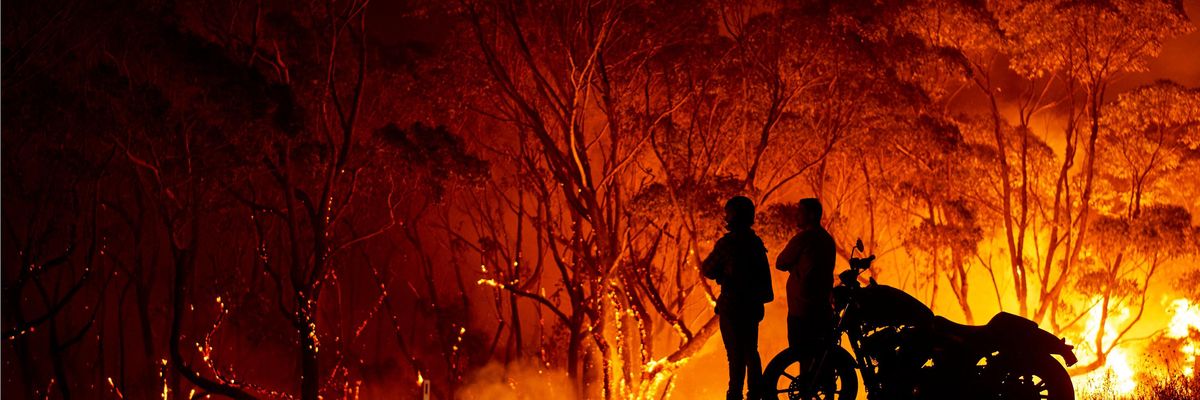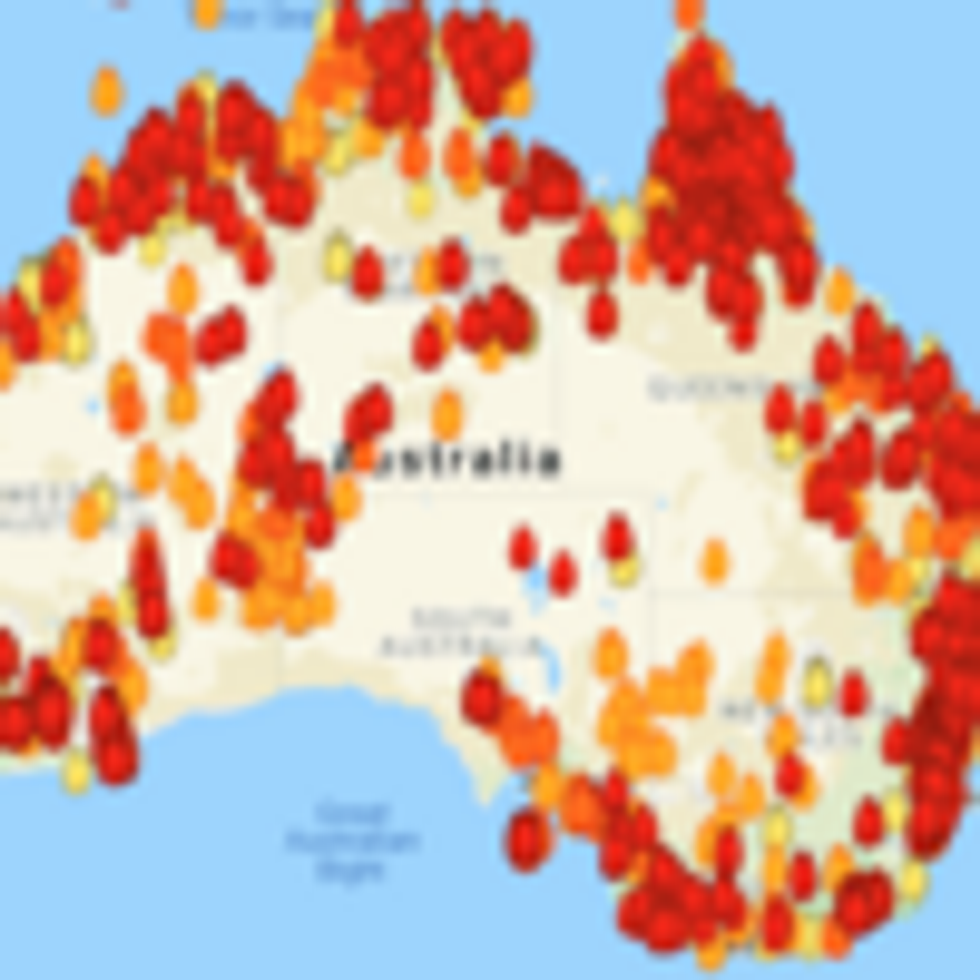

SUBSCRIBE TO OUR FREE NEWSLETTER
Daily news & progressive opinion—funded by the people, not the corporations—delivered straight to your inbox.
5
#000000
#FFFFFF
To donate by check, phone, or other method, see our More Ways to Give page.


Daily news & progressive opinion—funded by the people, not the corporations—delivered straight to your inbox.

Residents look on as flames burn through bush on January 4, 2020 in Lake Tabourie, Australia. (Photo: Brett Hemmings/Getty Images)
Scientists were stunned in early 2020 when bush fires that spread across Australia generated their own extreme weather patterns, including thunderstorms--and a study published Thursday revealed the blazes had an even greater climate impact than previously known.
Researchers at University of Exeter in England found that aerosols from the smoke created by the fires caused the highest temperatures in the Earth's stratosphere in decades and likely created a hole in the ozone layer over most of Antarctica.
"It is plausible that the good work carried out under the Montreal Protocol... could be undone by the impact of global warming on intense fires."
With global fossil fuel extraction and the global heating it causes showing few signs of slowing down, extreme weather events like the bush fires are likely to continue, said the authors of the study--and with them could come more damage to the ozone layer.
"Under global warming, the frequency and intensity of wildfires is expected to increase, which would lead to more" stratospheric warming and depletion of the ozone layer, study co-author Jim Haywood told The Washington Post.
Generally, volcanic eruptions like that of Mount Pinatubo in the Philippines in 1991 are the only phenomena on the planet which change the temperature of the stratosphere.
During the bush fires of early 2020, though, the temperature of the Earth's second atmospheric layer reached 3degC over Australia and 0.7degC across the globe.
As Tessa Koumoundouros explained at ScienceAlert, the heat-induced weather systems--called pyrocumulonimbus--caused by the fires "pumped the smoke into remarkably high altitudes, with the sun's rays heating the dark particles and causing them to rise further, in a process called self-lofting."
"Over the period of a month, the aerosol plume drifted across the South Pacific and was clearly detected in the stratosphere by [NASA instrument] CALIOP as well as surface-based lidars and sun-photometers operating from the southern tip of South America," the report, published in Scientific Reports, reads.
Unusually high temperatures in the stratosphere persisted for the first four months of 2020, and the continued heating likely caused changes in atmospheric circulation and chemical reactions on the surface of the smoke particles--depleting the ozone layer.
The impact of Australia's bush fires on the stratosphere were "unprecedented as far as the observational record goes," Olaf Morgenstern of New Zealand's National Institute of Water and Atmospheric Research told the Post.
Related Content

The research shows that continued global heating--and the wildfires that have been linked to the climate crisis--could reverse the success of the 1987 Montreal Protocol, which pushed the global community to end its production of ozone-damaging chemicals.
"It is plausible that the good work carried out under the Montreal Protocol," Haywood told the Post, "could be undone by the impact of global warming on intense fires."
Dear Common Dreams reader, The U.S. is on a fast track to authoritarianism like nothing I've ever seen. Meanwhile, corporate news outlets are utterly capitulating to Trump, twisting their coverage to avoid drawing his ire while lining up to stuff cash in his pockets. That's why I believe that Common Dreams is doing the best and most consequential reporting that we've ever done. Our small but mighty team is a progressive reporting powerhouse, covering the news every day that the corporate media never will. Our mission has always been simple: To inform. To inspire. And to ignite change for the common good. Now here's the key piece that I want all our readers to understand: None of this would be possible without your financial support. That's not just some fundraising cliche. It's the absolute and literal truth. We don't accept corporate advertising and never will. We don't have a paywall because we don't think people should be blocked from critical news based on their ability to pay. Everything we do is funded by the donations of readers like you. Will you donate now to help power the nonprofit, independent reporting of Common Dreams? Thank you for being a vital member of our community. Together, we can keep independent journalism alive when it’s needed most. - Craig Brown, Co-founder |
Scientists were stunned in early 2020 when bush fires that spread across Australia generated their own extreme weather patterns, including thunderstorms--and a study published Thursday revealed the blazes had an even greater climate impact than previously known.
Researchers at University of Exeter in England found that aerosols from the smoke created by the fires caused the highest temperatures in the Earth's stratosphere in decades and likely created a hole in the ozone layer over most of Antarctica.
"It is plausible that the good work carried out under the Montreal Protocol... could be undone by the impact of global warming on intense fires."
With global fossil fuel extraction and the global heating it causes showing few signs of slowing down, extreme weather events like the bush fires are likely to continue, said the authors of the study--and with them could come more damage to the ozone layer.
"Under global warming, the frequency and intensity of wildfires is expected to increase, which would lead to more" stratospheric warming and depletion of the ozone layer, study co-author Jim Haywood told The Washington Post.
Generally, volcanic eruptions like that of Mount Pinatubo in the Philippines in 1991 are the only phenomena on the planet which change the temperature of the stratosphere.
During the bush fires of early 2020, though, the temperature of the Earth's second atmospheric layer reached 3degC over Australia and 0.7degC across the globe.
As Tessa Koumoundouros explained at ScienceAlert, the heat-induced weather systems--called pyrocumulonimbus--caused by the fires "pumped the smoke into remarkably high altitudes, with the sun's rays heating the dark particles and causing them to rise further, in a process called self-lofting."
"Over the period of a month, the aerosol plume drifted across the South Pacific and was clearly detected in the stratosphere by [NASA instrument] CALIOP as well as surface-based lidars and sun-photometers operating from the southern tip of South America," the report, published in Scientific Reports, reads.
Unusually high temperatures in the stratosphere persisted for the first four months of 2020, and the continued heating likely caused changes in atmospheric circulation and chemical reactions on the surface of the smoke particles--depleting the ozone layer.
The impact of Australia's bush fires on the stratosphere were "unprecedented as far as the observational record goes," Olaf Morgenstern of New Zealand's National Institute of Water and Atmospheric Research told the Post.
Related Content

The research shows that continued global heating--and the wildfires that have been linked to the climate crisis--could reverse the success of the 1987 Montreal Protocol, which pushed the global community to end its production of ozone-damaging chemicals.
"It is plausible that the good work carried out under the Montreal Protocol," Haywood told the Post, "could be undone by the impact of global warming on intense fires."
Scientists were stunned in early 2020 when bush fires that spread across Australia generated their own extreme weather patterns, including thunderstorms--and a study published Thursday revealed the blazes had an even greater climate impact than previously known.
Researchers at University of Exeter in England found that aerosols from the smoke created by the fires caused the highest temperatures in the Earth's stratosphere in decades and likely created a hole in the ozone layer over most of Antarctica.
"It is plausible that the good work carried out under the Montreal Protocol... could be undone by the impact of global warming on intense fires."
With global fossil fuel extraction and the global heating it causes showing few signs of slowing down, extreme weather events like the bush fires are likely to continue, said the authors of the study--and with them could come more damage to the ozone layer.
"Under global warming, the frequency and intensity of wildfires is expected to increase, which would lead to more" stratospheric warming and depletion of the ozone layer, study co-author Jim Haywood told The Washington Post.
Generally, volcanic eruptions like that of Mount Pinatubo in the Philippines in 1991 are the only phenomena on the planet which change the temperature of the stratosphere.
During the bush fires of early 2020, though, the temperature of the Earth's second atmospheric layer reached 3degC over Australia and 0.7degC across the globe.
As Tessa Koumoundouros explained at ScienceAlert, the heat-induced weather systems--called pyrocumulonimbus--caused by the fires "pumped the smoke into remarkably high altitudes, with the sun's rays heating the dark particles and causing them to rise further, in a process called self-lofting."
"Over the period of a month, the aerosol plume drifted across the South Pacific and was clearly detected in the stratosphere by [NASA instrument] CALIOP as well as surface-based lidars and sun-photometers operating from the southern tip of South America," the report, published in Scientific Reports, reads.
Unusually high temperatures in the stratosphere persisted for the first four months of 2020, and the continued heating likely caused changes in atmospheric circulation and chemical reactions on the surface of the smoke particles--depleting the ozone layer.
The impact of Australia's bush fires on the stratosphere were "unprecedented as far as the observational record goes," Olaf Morgenstern of New Zealand's National Institute of Water and Atmospheric Research told the Post.
Related Content

The research shows that continued global heating--and the wildfires that have been linked to the climate crisis--could reverse the success of the 1987 Montreal Protocol, which pushed the global community to end its production of ozone-damaging chemicals.
"It is plausible that the good work carried out under the Montreal Protocol," Haywood told the Post, "could be undone by the impact of global warming on intense fires."